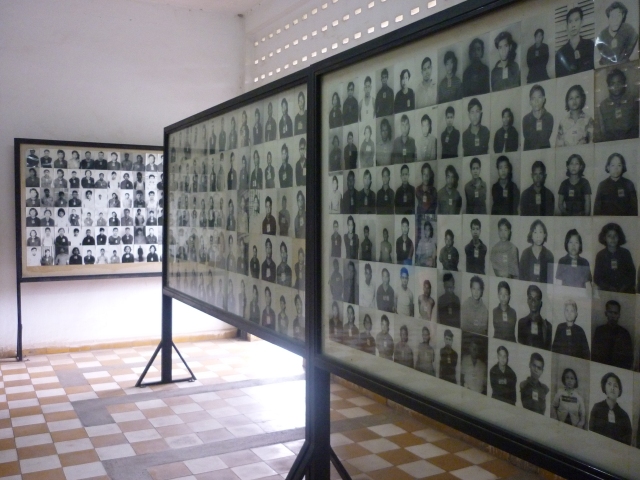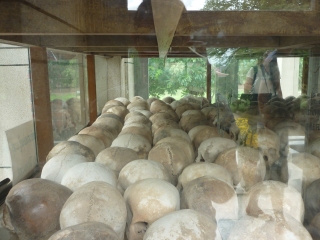EUROPE, CAMBODIA AND SYRIA ON THE HOLOCAUST MEMORIAL DAY
Today, 27th January, marks 69 years since Soviet troops liberated those imprisoned in Auschwitz. A day of remembrance, this date annually marks International Holocaust Day, a time for reflection on the atrocities which can be brought about by human hands.

Tuol Sleng Prison Cambodia
The murder of 6 million people across Europe in the Holocaust is transparent to all who have grown up Britain. Studying this abysmal part of European history in school means the Holocaust lives within European memory. Yet, it is also taught very much in the past tense, with a stance indicative of how such a disaster should never happen again. A survey by the Telegraph for Holocaust Memorial Day has revealed the diabolical flaws of our Eurocentric education system, with results that show 8 out of 10 young people cannot recall genocide since the Holocaust.
There remain millions of genocide victims who lie outside of mainstream consciousness, including those who are currently suffering. We cannot treat this as a day of remembrance while such atrocities are ongoing; this is a day for activism and awareness. We should not stand still to remember the deaths of genocide victims knowing that there are victims currently dying who could be saved. The victims of the Holocaust should be paid tribute through direct action, remembering the dead by saving the dying.
Thirty years after Auschwitz was liberated, Pol Pot and the Khmer Rouge declared the communist state of Kampuchea in Cambodia and set about creating a concentrated hell on earth. Within 4 years, when the Vietnamese finally liberated Cambodia, Pol Pot and his army had brutally murdered 1 in 4 Cambodian people (2 million of a population of 8 million).
Even more fearful because it was so random, Pol Pot made everyone his target, from political threats to people who wore glasses. Much like the European Holocaust, the majority of the Khmer Rouge’s murders were carried out in ‘killing fields’ and torture prisons. This summer I visited the killing field Cheoung Ek which witnessed the deaths of around 20,000 people who were brutally killed with farming tools and chemicals over the ominous backdrop of propaganda music. By 1978 trucks were bringing about 750 victims a day to Cheoung Ek.

Cheoung Ek Killing Fields Cambodia
Cheoung Ek was one of hundreds of other killing fields situated throughout Cambodia during the Khmer Rouge regime and was so well hidden that only the soldiers who worked there knew it existed. As such, it was only discovered after Cambodia’s liberation because a young man digging for potatoes pulled a dead body from the ground. He then found pieces of flesh and hair on a tree in the field which had been used to murder young children.
Today, this particular killing field has become the main memorial site for those murdered by the Khmer Rouge. At the centre stands a monument of remembrance which also houses many of the bones found in the fields. While many of the mass graves have been excavated and the bones respectfully buried, fragments of cloth and bone continually appear after rain, a constant reminder of how fresh the scars of the Cambodian genocide are.
Visiting Cheoung Ek is a wholly different experience from that of Auschwitz. Where the latter is a well preserved, respectful memorial site detached from the visitor with glass panels, the former is an overgrown field of grass, hair, cloth and bone. Towards the end of the route around the killing fields I came within centimetres of treading on someone’s jawbone with teeth still attached.
This display of bones, heart wrenching stories, music and harrowing sounds is only where the trauma begins in Cambodia. Where a visit to Auschwitz almost marks a cathartic opportunity to pay your respects to the millions of Holocaust victims you have studied about but hitherto been detached from; the killing fields generate a cleansing of perception which leads you to see every element of the country differently.

Tuol Sleng Prison Cambodia
In our journey from Cheoung Ek to the torture prison Tuol Sleng we passed a mass rally for the Cambodian People’s Party ahead of this summer’s elections, only a week away at that point. Worryingly, the music played through loudspeakers from the parade was chillingly similar to that which we had just heard cover up the sound of the murderous generator at the killing fields.
The Cambodian People’s Party who were victorious in this summer’s elections were formerly known as the Kampuchean People’s Revolutionary Party, the sole party who governed during Pol Pot’s reign of terror. One Cambodian told me of their desire for governmental change: “I would like the other party to win. This one are basically communist. They make petrol very expensive for me. There is a lot of corruption.”
Naturally, revolution is not seen as a desirable option in Cambodia, with the scars of the last takeover still so fresh. The fear generated by Pol Pot remains, with another Cambodian responding hesitantly when I asked him about the election. He looked over his shoulders multiple times before responding very quietly “with money comes the political power, the small person like me has no say.”
This January there have been murderous riots in Pnomh Penh, with Cambodian workers demanding an increase in the national minimum wage. At $60 a month the minimum wage, sustained by the likes of Nike, Gap, Adidas and Puma, is not enough to live on. For many Cambodians, life has not improved since Pol Pot’s regime, which is ever present in today’s ex-Khmer Rouge run government who are deploying murderous riot police to quell protestors.
Ten thousand miles away in Syria, a recent report on the ‘Torture and Execution of Persons incarcerated by the current Syrian regime’ has revealed murderous trends uncannily similar to those shown in the rooms of Tuol Sleng. More than two million Syrians have been forced to leave their homes to escape the daily bloodbath of civil war. This week, the UK’s government were arguing over whether or not they should agree to offer sanctuary to just a few hundred Syrian refugees.
We should not be passive in our remembrance of genocide victims on this International Holocaust Memorial Day, but should seek out ways in which we can help those currently in danger and in need of support.
Comments
Post a Comment